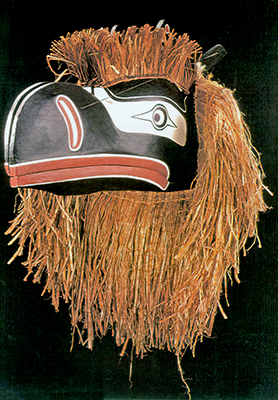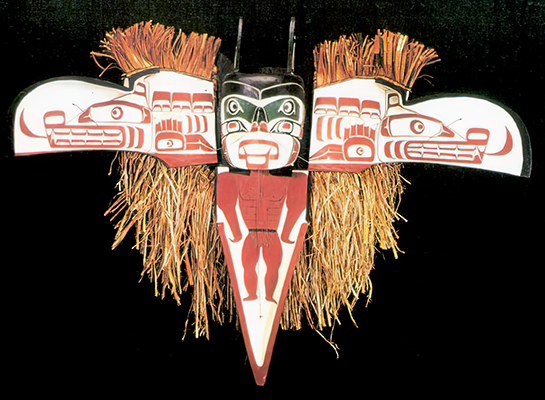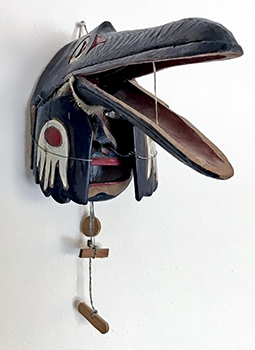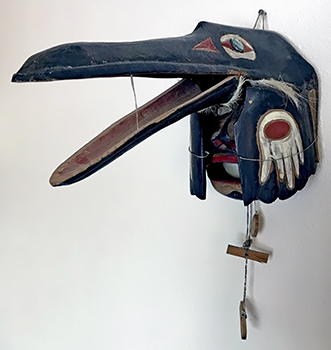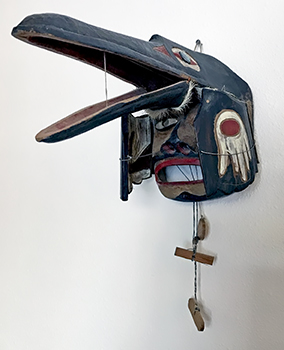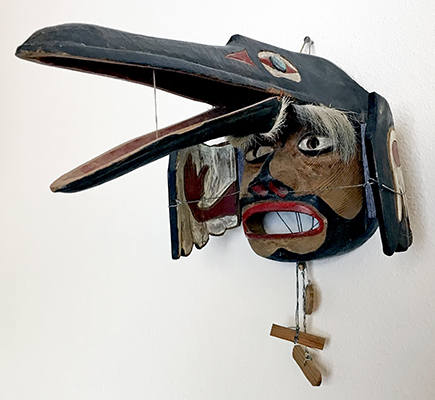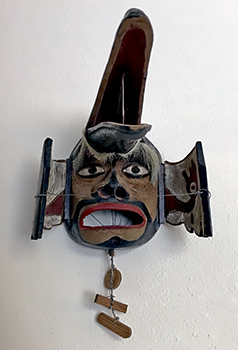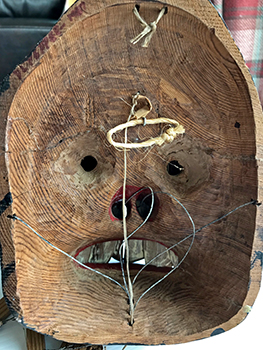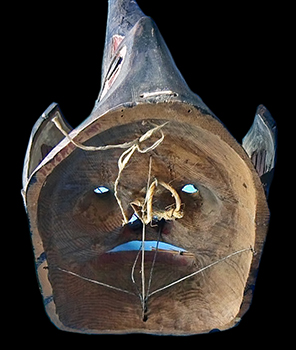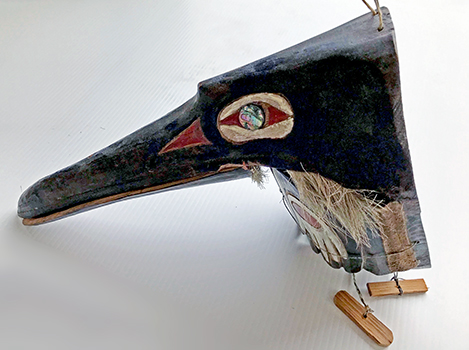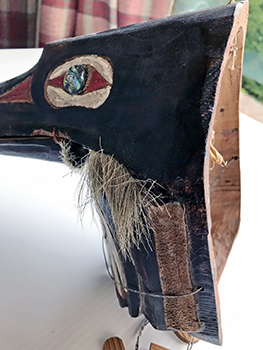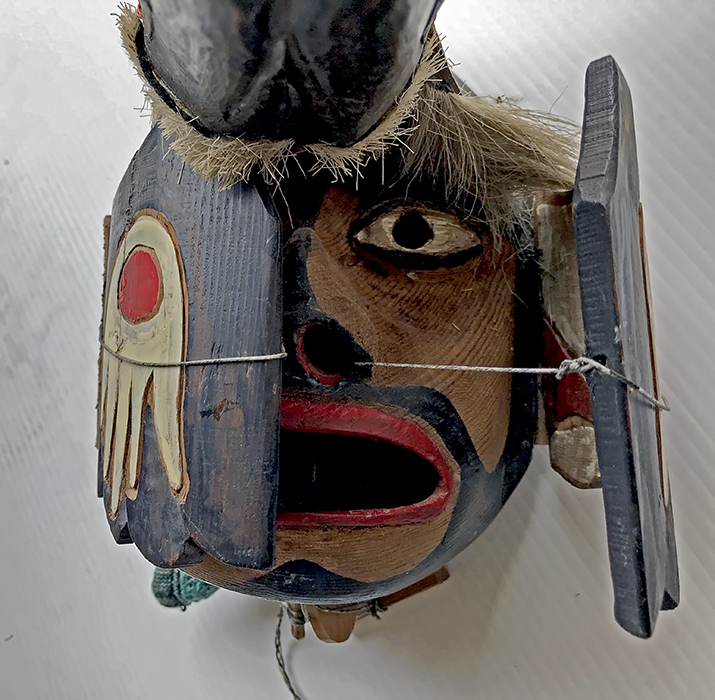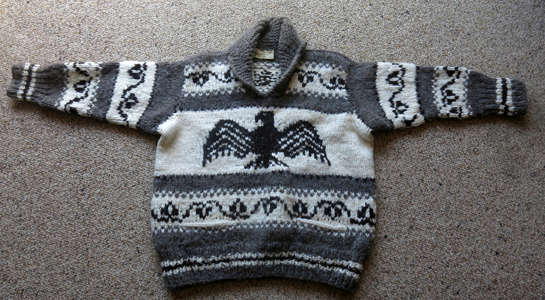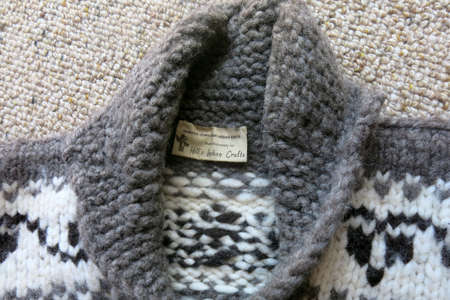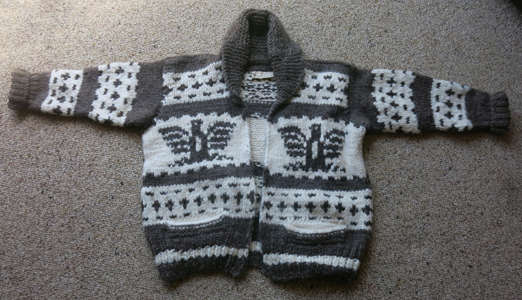Back to Don's Maps
 Back to Archaeological Sites
Back to Archaeological Sites
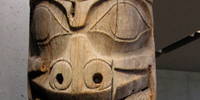 Back to Pacific NW Coast index
Back to Pacific NW Coast index
Clothing, Masks and Weaving of the First Nations of the Pacific Northwest
The Indigenous peoples of the Pacific Northwest Coast are the pre-Columbian inhabitants of the Pacific Northwest Coast, their descendants, and many ethnic groups who identify with those historical peoples. They are now situated within the Canadian Province of British Columbia and the U.S. states of Alaska, Washington and Oregon.
The indigenous peoples of the Pacific Northwest Coast at one time had the most densely populated areas of indigenous people. The land and waters provided rich natural resources through cedar and salmon, and highly structured cultures developed from relatively dense populations. Within the Pacific Northwest, many different nations developed, each with their own distinct history, culture, and society. Some cultures in this region were very similar and share certain elements, such as the importance of salmon to their cultures, while others differed. Prior to contact, and for a brief time after colonisation, some of these groups regularly conducted war against each other through raids and attacks. Through warfare they gathered captives for slavery.
The creation of beautiful and practical objects (for all tribal communities) served as a means of transmitting stories, history, wisdom and property from generation to generation. Art provided Indigenous people with a tie to the land by depicting their histories on totem poles the Big (Plank) Houses of the Pacific Northwest coast – the symbols depicted were a constant reminder of their birth places, lineages and nations. Due to the abundance of natural resources and the affluence of most Northwest tribes, there was plenty of leisure time to create art. Many works of art served practical purposes, such as clothing, tools, weapons of war and hunting, transportation, cooking, and shelter; but others were purely aesthetic.
The First Nations people of the Northwest Coast have a very rich tradition of hats, cloaks, body armour, and masks. Before Europeans arrived and introduced cloth, most coastal people wore minimal clothing. Men went naked when weather permitted and women would wear a simple skirt made of shredded cedar fibre. Both sexes wore woven bark capes and spruce root hats as a protection from the rain.
Text above: Wikipedia and http://www.bcarchives.gov.bc.ca/
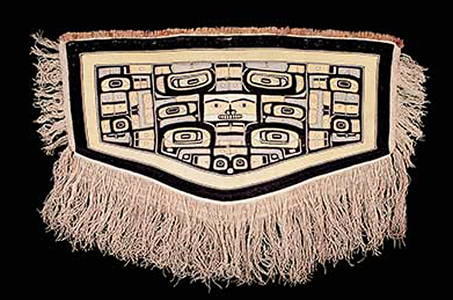
Gwiis Halaytyt (Dancing Robe)
A Gwiis Halayt could only be worn by Simgitgat (chiefs). The weaving of this type of 'Chilkat' dancing robe originated with the Nisga’a. Each blanket is made from dyed mountain goat wool and cedar bark, and required as much as a year to complete. The complex design is an ayukws (crest) of a Nisg-a’a wilp (house). Acquired at Lax-g-alts’ap, likely from a sim’oogit of Ank’idaa, 1905.
Photo and text: http://nisgaamuseum.ca/node/32

Tlingit ceremonial dance blanket
The blanket is woven in pale yellow and blue against a rich black ground, with a central rectangular face, within an abstract totemic field enclosing stylised wings, eyes and other crest characteristics, the lateral fields similarly ornamented; four corner ties in black and yellow remaining at each side.
Width 65 3/4 in, 167 cm
Photo and text: http://www.sothebys.com/
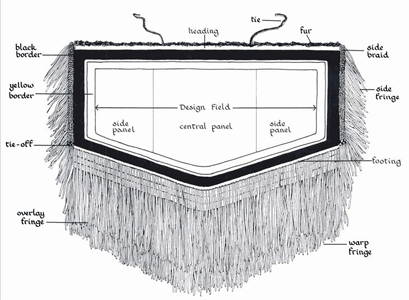
The overall design of these robes, often called Chilkat blankets, is very standardised, although each one is unique. They are superbly made, with mountain goat's wool completely covering a core of shredded and twisted cedar bark.
Photo: Samuel (1990)

James Jackson (Anaaxoots or Annihootz or Annahootz) (left) and Augustus Bean (K’alyaan Eesh, or Klonish) (right)
Head men of the Bear Clan at Sitka potlatch, Dec. 23, 1904
The two men are wearing Chilkat blankets and hats; full length; black background. Photograph heavily retouched by creator. Photographer's number 101.
Photo: Alaska State Library, Case & Draper Photograph Collection, PCA 39-784, ASL-P39-0784, Case and Draper Collection of Photographs, 1898-1920
Source and text: http://vilda.alaska.edu/cdm/singleitem/collection/cdmg21/id/53/rec/56
Raven/Sisutl transformation mask.
A Raven/Sisutl transformation mask in the permanent collection of The Children’s Museum of Indianapolis.
This modern piece for exhibition illustrates an alternative method for revealing the mythical being hidden inside the mask. The lower beak is able to be manipulated for speech, and the upper beak has been split to allow it to open up to show the mythical being behind it.
In addition, the lower beak in this rendition forms the body of the mythical being when the mask is in its fully open position.
Artist: Oscar Matilpi, Kwakwaka'wakw Nation, 1996
Photo: Randy Johnson
Source: This image was provided to Wikimedia Commons by The Children's Museum of Indianapolis as part of an ongoing cooperative project. The artifact represented in the image is part of the permanent collection of The Children’s Museum of Indianapolis.
Permission: Creative Commons Attribution-Share Alike 3.0 Unported license
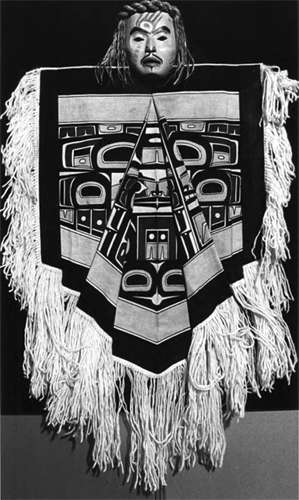
Blanket and Mask
Mask and blanket display - art works created by students of the Gitanmaax School of Northwest Coast Indian Art located at the 'Ksan Historical Village.
Language Group: Tsimshian
Sub-language Group: Gitxsan
Village: Ksan Historical Village
Photo: © G.F. MacDonald Collection, 1972
Permission: Courtesy George MacDonald, Director, Bill Reid Centre for NWC Art Studies at Simon Fraser University, Vancouver, BC.
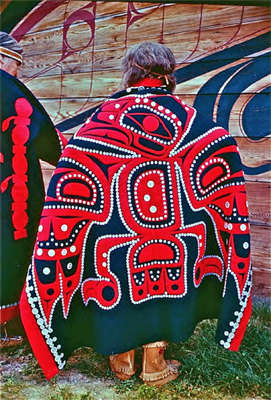
Button Blanket
Mrs. Morrison in a button blanket. The pole crest on other blanket is after a pole at Kisgegas.
Language Group: Tsimshian
Sub-language Group: Gitxsan
Village: Ksan Historical Village
Photo: © G.F. MacDonald Collection, 1972
Permission: Courtesy George MacDonald, Director, Bill Reid Centre for NWC Art Studies at Simon Fraser University, Vancouver, BC.

Gitxsan chief Ernest Hyzims poses in a Dog Fish blanket at 'Ksan Historical Village
Language Group: Tsimshian
Sub-language Group: Gitxsan
Village: Ksan Historical Village
Photo: © G.F. MacDonald Collection, 1972
Permission: Courtesy George MacDonald, Director, Bill Reid Centre for NWC Art Studies at Simon Fraser University, Vancouver, BC.

Button Blankets and Transformation Masks
Ksan carvers and dancers, Walter Harris with back to camera, Art Strerrit dancing with mask in background. Ksan village.
Language Group: Tsimshian
Sub-language Group: Gitxsan
Village: Ksan Historical Village
Photo: © G.F. MacDonald Collection, 1972
Permission: Courtesy George MacDonald, Director, Bill Reid Centre for NWC Art Studies at Simon Fraser University, Vancouver, BC.
An important transformation mask
The Pacific Northwest Coast First Nations, and particularly the Kwakwaka’wakw Nation, have a tradition of transformation masks, which allow the performer/dancer to change from an animal such as the raven into a mythical being. The masks and capes used are often part of performances at Potlatch ceremonies. The masks have cords to open and move parts of the mask, animating it in order to tell stories and sing songs.This mask may be from an artist of the Kwakwaka’wakw Nation.
Typically, the dancer tells or sings a story, accompanied by movements of the mask, allowing the audience to see the mask apparently talking, as (for the raven or eagle masks) the beak opens and closes, giving the impression of speech coming from the dancer.
At the culmination of the story, the dancer/performer is able to suddenly, to great effect, open the beak of the bird fully, or in this case open the wings, to reveal the face of a humanoid, powerful, mythical being.
This particular mask shown below is important and more versatile than most because it allows the performer to switch far more dramatically from telling the story to the denouement of revealing the face of the mythical being.
In masks with the face between the upper and lower beaks of the raven or eagle, this revelation is preempted by the inadvertent and unavoidable showing of the mask within the beak. In the case of this mask, the change from the raven telling a story, to the presentation of the mythical being is far more dramatic and impressive.
Other masks such as that of Eagle Mask closed, from Alert Bay, Vancouver Island, by a Kwakwaka’wakw artist, have achieved the same result by splitting the upper beak into two halves to reveal the mythical being, while preserving the lower movable beak for the first part of the performance, where the eagle is 'speaking' from the mask.
Kilroy-Ewbank (2021) is a good reference on transformation masks. Dr Kilroy-Ewbank writes:
Kwakwaka’wakw bands are arranged into four clans (Killer Whale, Eagle, Raven, and Wolf clans). The clans are divided into numayn (or ‘na’mina), which can be loosely translated as 'group of fellows of the same kind' (essentially groups that shared a common ancestor). Numayns were responsible for safe-guarding crest symbols and for conveying their specific rights - which might include access to natural resources (like salmon fishing areas) and rights to sacred names and dances that related to a numayn's ancestor or the group’s origins. The numayn were ranked, and typically only one person could fill a spot at any given moment in time. Each rank entailed specific rights, including ceremonial privileges - like the right to wear a mask such as the Brooklyn Museum's Thunderbird transformation mask. Animal transformation masks contained crests for a given numayn. Ancestral entities and supernatural forces temporarily embody dancers wearing these masks and other ceremonial regalia.
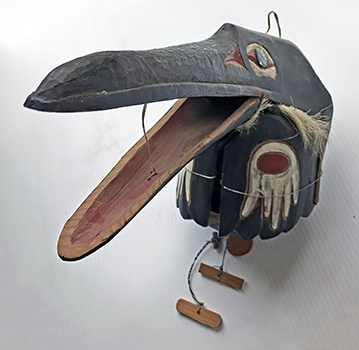
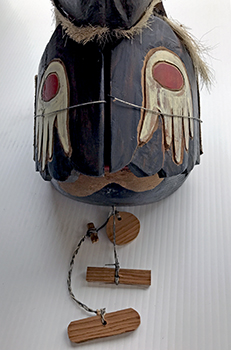
The wings close, completely hiding the mythical figure inside.
On each of the wings is a carved white hand, decorated with a red spot.
Photos: Courtesy of the owner
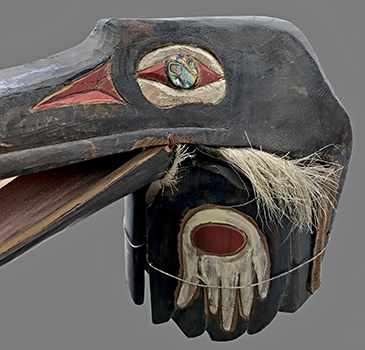
The abalone shell used for the eye has been particularly well chosen and prepared. It is probably of California abalone, obtained by trade. The species native to the Northwest Coast is not as colourful as the California species, and now that the North American abalone is protected, abalone shell is imported from New Zealand and more southerly American climes.
Photo: Courtesy of the owner
Additional text: Shearar (2000)
The mask has a movable lower beak, allowing the Raven to 'speak'.
Photos: Courtesy of the owner
At the appropriate time, the performer opens the wings to reveal the mythical figure with great effect.
Photos: Courtesy of the owner
The cords which control the beak and wings have differently shaped wooden tags, which allow the performer to immediately know which cord is which.
Photos: Courtesy of the owner
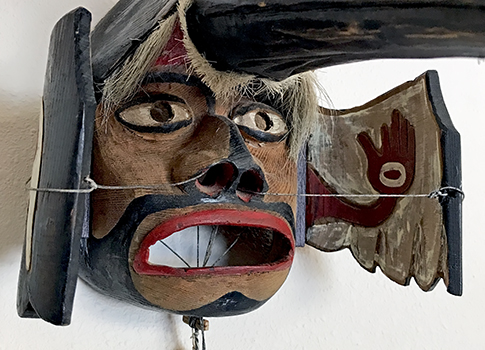
On the inside of each wing is a red hand on which a white, red centred eye has been painted on the palm.
Since this unusual design is repeated on the outside of the wing as well, it would appear to be an identifier of some kind, possibly the numayn to which the carver belonged.
Photo: Courtesy of the owner
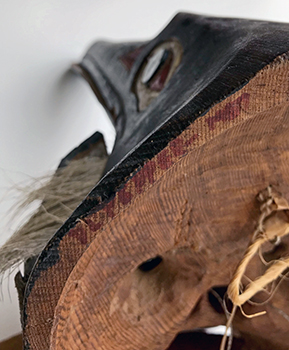
Above are good views of the back of the mask, showing the cords used to manipulate the transition mask, the holes for the eyes, nostrils and mouth, as well as the two thick string anchors for the attachment of a (possibly leather, or a wooden frame and netting) harness or hood to fit over the wearer's head.
Also shown in closeup at left is the illegible signature and date of 1947 in red.
These photographs show that the mask was not meant to be 'worn' in close contact with the dancer's face. The strings used to move the various parts of the mask preclude that. Thus there would have had to have been a well constructed 'harness' or 'basket' on the wearer's head to which the mask was attached. Two coarse modern cords can be seen towards the top of the mask which must have been used for this attachment to the 'harness'.
Photos: Courtesy of the owner
The mask has a complex shape.
The wings are attached via a leather hinge, while the lower beak is hinged on what is possibly a later repair, pieces of copper wire.
Here the eye made of abalone shell and its surrounding painting are shown to advantage.
Photos: Courtesy of the owner
The dramatic possibilities of this mask in the hands of a master performer are endless.
Photo: Courtesy of the owner
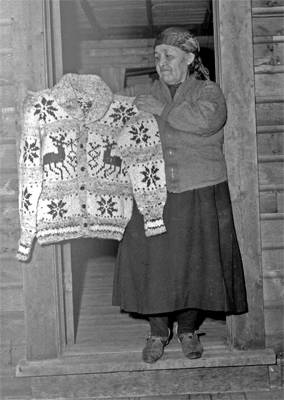
Cowichan Indian Sweater Maker, between 1941 and 1943.
Photo: Williams Bros. Photographers Collection
Donation: Donn B.A. Williams in 1987
Source: http://searcharchives.vancouver.ca/cowichan-indian-sweater-maker;rad
Permission: Public Domain
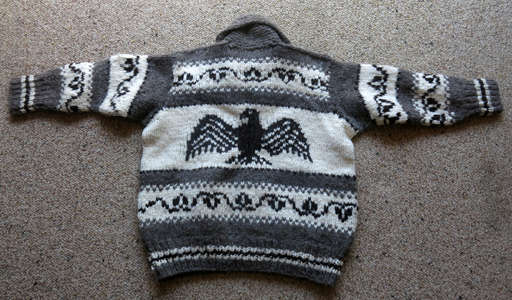
Cowichan unzippered sweater, ca 1966
The fashion in Canada is for a cardigan style, opening sweater. Originally a buttoned closure was used, though now a zippered closure is the norm. Preferring the unzippered style of sweater, I had this 'Thunderbird' motif sweater specially made for me when I lived in Canada, ordered through the Hudson's Bay Company Department Store.
The label has yellowed a bit in 47 years, but the sweater is as good as new.
The Hudson's Bay Company, commonly referred to as 'The Bay' is the oldest commercial corporation in North America (in continuous operation for over 340 years) and one of the oldest in the world. A fur trading business for much of its existence, today the Hudson's Bay Company owns and operates retail stores throughout Canada and the United States.
Photo: Don Hitchcock 2013
Additional text adapted from Wikipedia
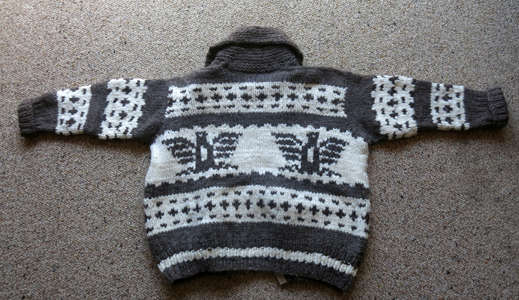
Cowichan zippered sweater, ca 2000
Note that the label has not changed its design in at least 34 years.
Photo: Don Hitchcock 2013
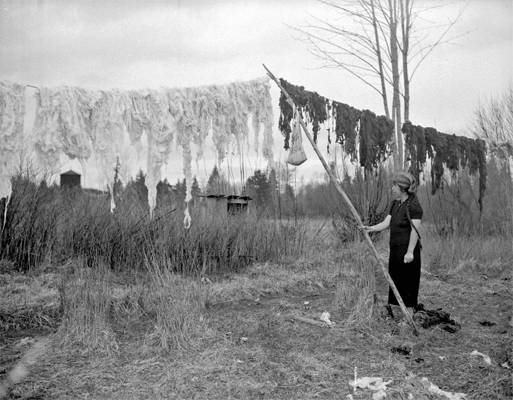
Cowichan wool being hung to dry, between 1941 and 1943.
Photo: Williams Bros. Photographers Collection
Donation: Donn B.A. Williams in 1987
Source: http://searcharchives.vancouver.ca/cowichan-wool-being-hung-to-dry-3;rad
Permission: Public Domain

Cowichan wool being hung to dry, between 1941 and 1943.
(All the wool used in the sweaters is self-coloured, that is, the wool comes from white, brown, grey and black sheep, and no dyes are used - Don )
Photo: Williams Bros. Photographers Collection
Donation: Donn B.A. Williams in 1987
Source: http://searcharchives.vancouver.ca/cowichan-wool-being-hung-to-dry-3;rad
Permission: Public Domain


Armour and Helmet Display
The 'Ksan Performance group re-enacting the story of the warrior chief Nehl'xt or 'Nekt at 'Ksan Historical Village. The story takes place at 'Battle Hill' near Gitwangak village. 'Nekt was an aggressive warrior and led many successful raids against neighbouring tribes. He is remembered and celebrated by the Gitxsan people as a powerful and great leader.
Language Group: Tsimshian
Sub-language group: Gitxsan
Village: Ksan Historical Village
Photo: G. F. MacDonald Collection, 1979
Permission: Courtesy George MacDonald, Director, Bill Reid Centre for NWC Art Studies at Simon Fraser University, Vancouver, BC.
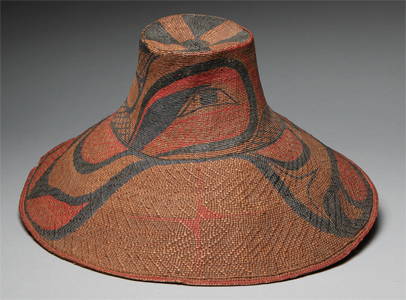
Haida polychrome twined hat
The hat is of classic tapering form, very finely and tightly woven in split spruce root, in three-strand skip stitch twining techniques, with a concentric zigzag pattern on the brim, a smoother texture on the head covering the crown, overlaid by painted totemic crest designs in red and black pigments.
height 7 1/2 in, 19 cm by diameter 16 in, 40.5 cm
Photo and text: http://www.sothebys.com/
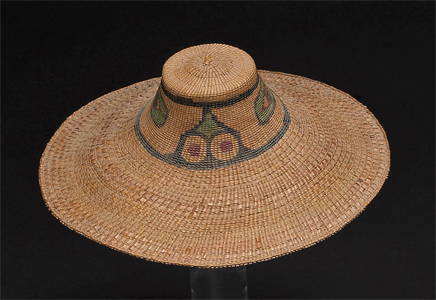
Haida painted basketry hat
Decorated around the crown with mirror-image totemic animal effigy motifs.
Height 140 mm, diameter 394 mm
Photo and text: http://www.bonhams.com/auctions/20296/lot/1045/

A woven cedar bark hat, hand painted with a frog, by Charles Edenshaw. The four-pointed star with bicoloured points is the signature of this artist.
Collected at Masset in 1911 by C. C. Perry.
CMC VII-B-899 (S92-4284)
Photo and text: http://www.civilization.ca/cmc/exhibitions/aborig/haida/haacp09e.shtml
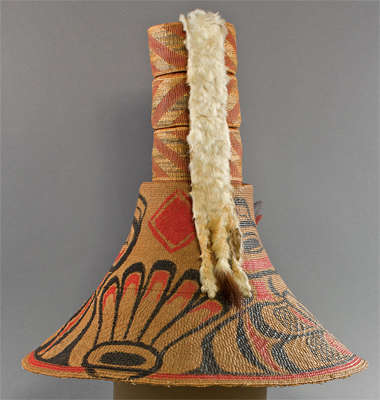
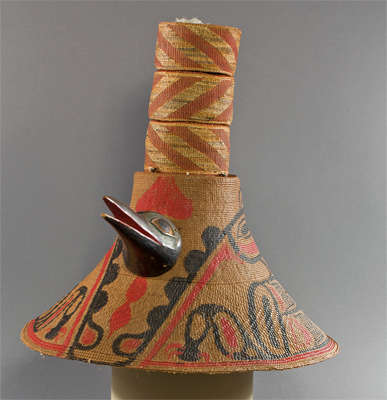
Raven Hat with Hat Ornament, ca 1900, wood, spruce root, and paint.
This hat is an excellent example of the High-Crowned or Ringed Hat. It was worn by high ranking Haida and Tlingit people. Finely woven of split spruce roots, the wide brimmed hats have several woven cylinders topping the crown. These cylinders are called skils by the Haida. It is thought that the number of cylinders, or rings, represents the number of potlatches given by the owner, thus the term 'potlatch rings' or 'potlatch cylinders'.
Another theory is that a specific number of rings or cylinders was, in itself, a crest. This seems quite probable, since some of these hats, painted with the family crests, were crests themselves. Certainly, the high crowned or ringed hat points to chiefly status and high rank, and poles that include these hats symbolise the status of the chiefs on whose poles they are carved.
Occasionally, a plain column of such rings was carved on a pole, in association with a figure, human or animal; or a whole section of a pole was carved to represent the stacked cylinders.
(note that the bird may thus well be the crest of the owner. It was also common to attach a strip of fur to the top of such hats as is the case here - Don )
Museum Purchase: Indian Collection Subscription Fund, Rasmussen Collection of Northwest Coast Indian Art, no known copyright restrictions, 48.3.596A,B
Photo and text: http://portlandartmuseum.us/mwebcgi/mweb.exe?request=record;id=10234;type=101#
Additional text: Stewart (1993)
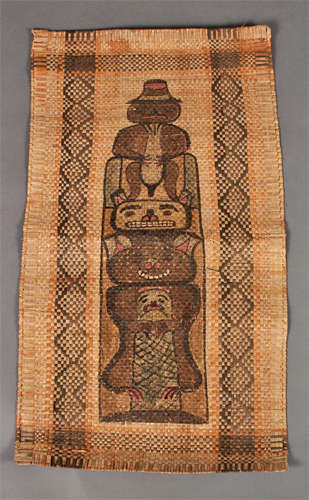
Unknown Haida artist, Mat, ca. 1890, painted cedar bark.
Museum Purchase: Indian Collection Subscription Fund, Rasmussen Collection of Northwest Coast Indian Art, no known copyright restrictions, 48.3.584
Photo and text: http://portlandartmuseum.us/mwebcgi/mweb.exe?request=record;id=10221;type=101

Unknown Haida artist, Mat, ca. 1890, painted cedar bark.
Museum Purchase: Indian Collection Subscription Fund, Rasmussen Collection of Northwest Coast Indian Art, no known copyright restrictions, 48.3.585
Photo and text: http://portlandartmuseum.us/mwebcgi/mweb.exe?request=record;id=10222;type=101#
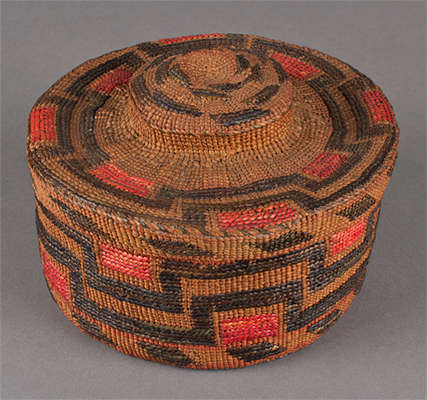
Unknown Haida artist, Rattle Top Basket, ca. 1900, spruce root and grasses.
These baskets took up to 300 hours to make, and the lid had small pebbles or lead shot in it so that it rattled when shaken. They were made in winter.
They are generally called a spruce root twined rattle top basket, made of a mixture of spruce roots and native grasses. They were highly valued, and were a great source of revenue for many west coast peoples including the Tlingit.
In the spring the women would go and strip the roots of the Sitka spruce. The delicate baskets have a lot of stitches per inch. The colours may be aniline dyes, which came in during the 20th Century. The baskets are flexible, and often examples have breaks on the rims, and they break easily on the seams.
The Elizabeth Cole Butler Collection, no known copyright restrictions, 2013.1.36 a,b
Photo and text: http://portlandartmuseum.us/mwebcgi/mweb.exe?request=record;id=33869;type=101#
Additional text: http://video.pbs.org/video/2339285220/

Naas shagi yeil s'aaxw (Raven at the Headwaters of Nass hat)
Tlingit, Gaanax.ádi clan, Taku.
Attributed to Kadyisdu.axch', Tlingit, Kiks.ádi clan, active late 18th – early 19th century.
Description: Ceremonial hat
Date: ca 1810; photo 2010-12-18
Medium : Maple, paint, shell, hair, baleen
Current location: Seattle Art Museum
Accession number: 91.1.125
Object history: Gift of John H. Hauberg and John and Grace Putnam
Notes: There are human figures crouching within Raven's ears.
Photo: Joe Mabel
Permission: Creative Commons Attribution-Share Alike 3.0 Unported license
Text: Wikipedia
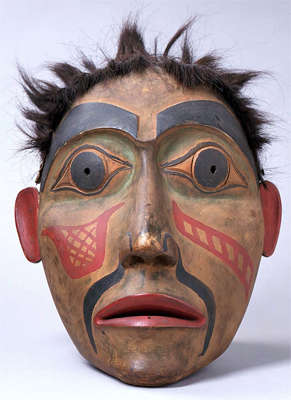
Portrait Mask, ca. 1900, unknown Haida artist, wood, paint, and hair.
Museum Purchase: Indian Collection Subscription Fund, Rasmussen Collection of Northwest Coast Indian Art, no known copyright restrictions, 48.3.402
http://portlandartmuseum.us/mwebcgi/mweb.exe?request=record;id=10020;type=101#
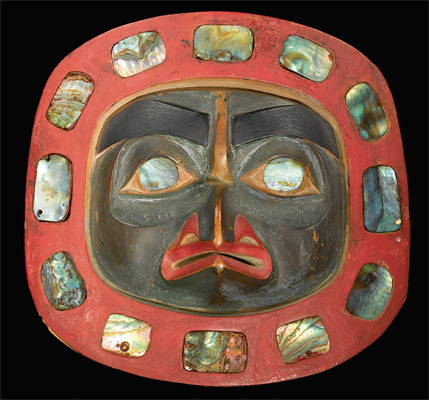
Tlingit polychrome wooden headdress
This frontlet, (band worn on the forehead ) of slightly convex form, is finely carved with a bird, probably a raven, with recurved beak, high pointed cheekbones, and pointed oval eye rims inset with rich blue green plaques of abalone shell as pupils beneath sharply arching brows, enclosed by a deeply recessed groove, surmounted by a flattened border, painted in vermilion red and inlaid with plaques of abalone shell.
Height 6 1/2 in, 16.5 cm, Width 6 1/4 in, 16 cm.
Photo and text: http://www.sothebys.com/
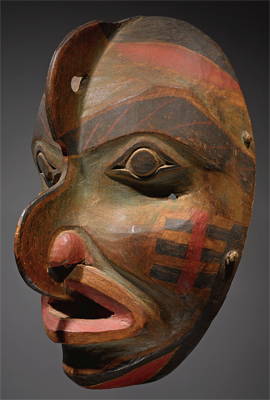
Tlingit polychrome wood mask
The mask is composed of carved wood and pigments, probably a representation of a human/hawk hybrid; pierced twice at each side and tied with hide straps for suspension.
Height 9 3/4 in, 25 cm.
Photo and text: http://www.sothebys.com/

Bear Mask
Bear through the ring of the sun Mask created by Earl Muldoe
Language Group: Tsimshian
Sub-language Group: Gitxsan
Village: Ksan Historical Village
Photo: G.F. MacDonald Collection, 1972
Permission: Courtesy George MacDonald, Director, Bill Reid Centre for NWC Art Studies at Simon Fraser University, Vancouver, BC.
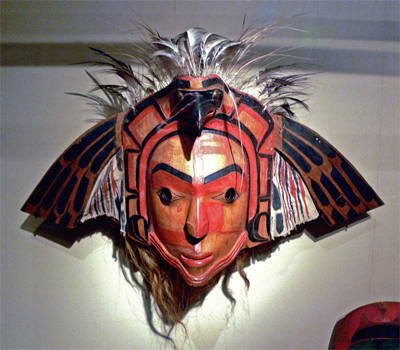
Eagle mask with movable wings
Nootka
Jacobsen collection, 1881
Photo: FA2010, February 2009
Permission: Public Domain
Text: Wikipedia
Source: North America department, Ethnologisches Museum, Berlin, Germany
References
- Inverarity, R., 1967: Art of the Northwest Coast Indians, Second Edition, University of California Press, 01/08/1967
- Kilroy-Ewbank, L., 2021: Transformation masks, Smarthistory, August 9, 2015, accessed August 15, 2021, https://smarthistory.org/transformation-masks/.
- Mayer, C., Shelton A., 2010: The Museum of Anthropology at the University of British Columbia, University of Washington Press, February 15, 2010
- Samuel, C., 1990: The Chilkat Dancing Blanket, University of Oklahoma Press, September 15, 1990
- Shearar, C., 2000: Understanding Northwest Coast Art, A Guide to Crests, Beings and Symbols, 192 Pages, 6 x 9 in, 70 illus. ISBN: 9780295979731
- Stewart, H., 1993: Looking at Totem Poles, Douglas & McIntyre, 01/01/1993 - Indians of North America - 191 pp.
Back to Don's Maps
 Back to Archaeological Sites
Back to Archaeological Sites
 Back to Pacific NW Coast index
Back to Pacific NW Coast index
